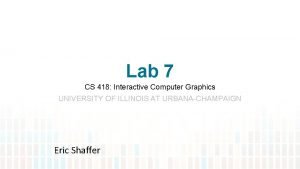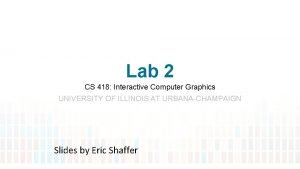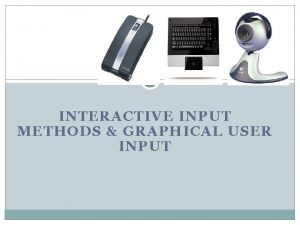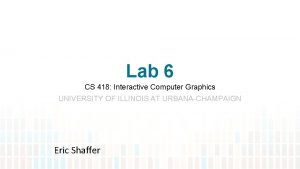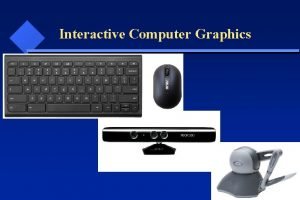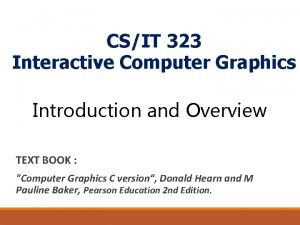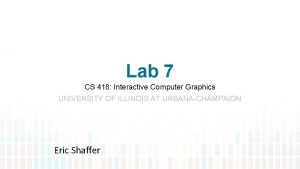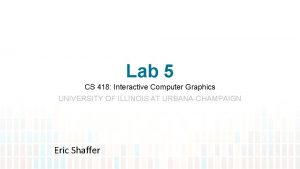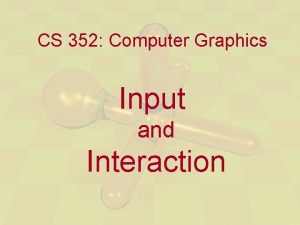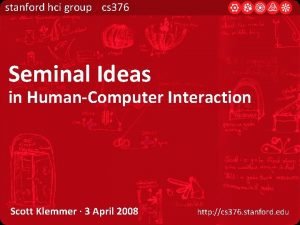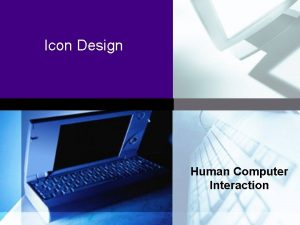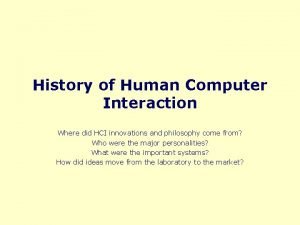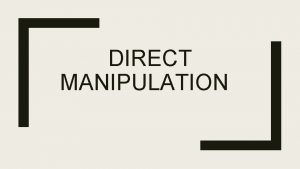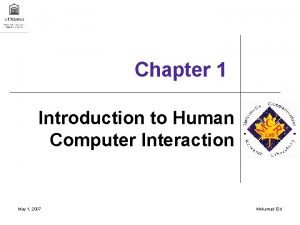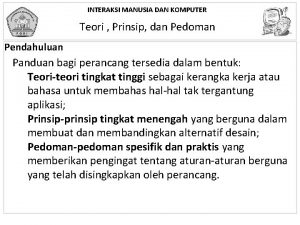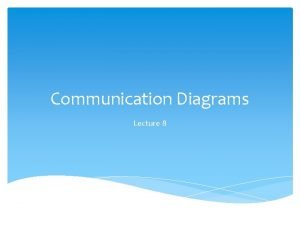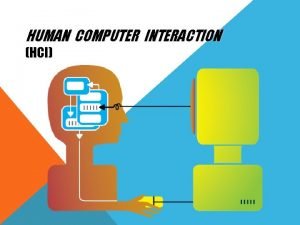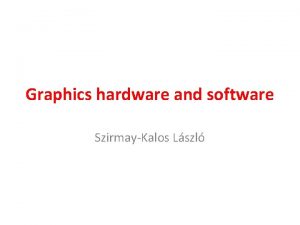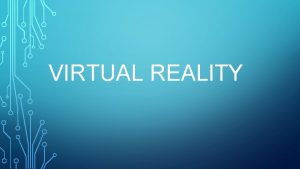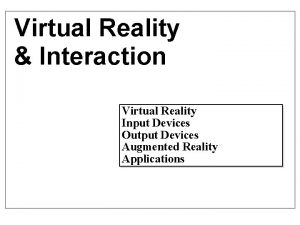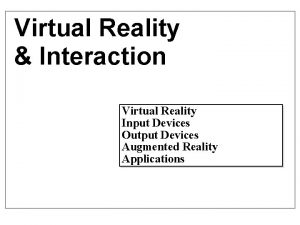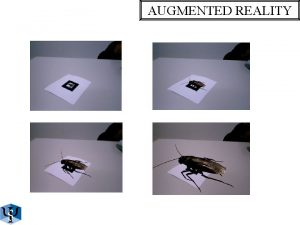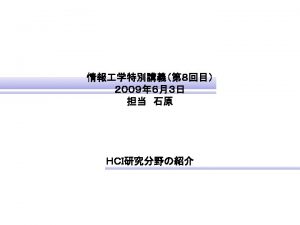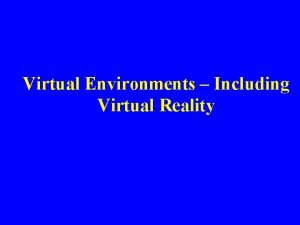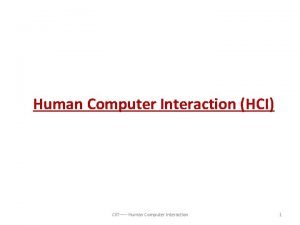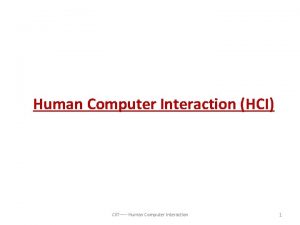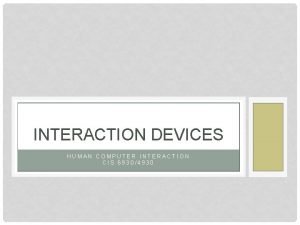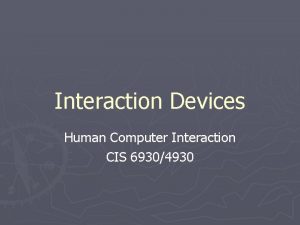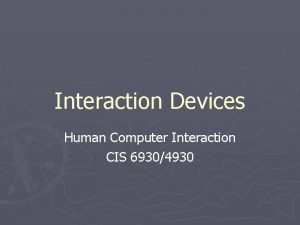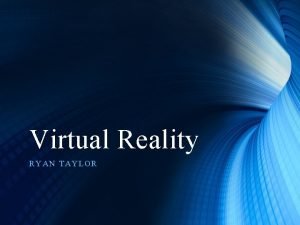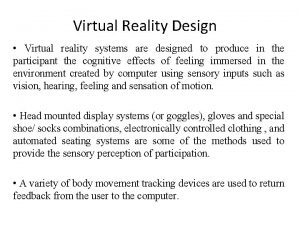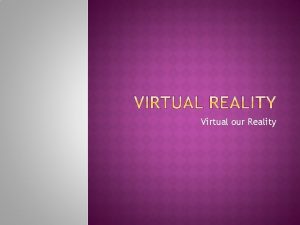Interactive Computer Graphics Human Computer Interaction Virtual Reality



























- Slides: 27

Interactive Computer Graphics, Human Computer Interaction, Virtual Reality and Digital Arts and Sciences Benjamin Lok September 20 th, 2004

Outline u Topics • Interactive Computer Graphics • Human Computer Interaction • Virtual Reality Jobs u Research u Skills u

Interactive Computer Graphics

Motivation u We want to understand how to do:

Motivation

Why should I take this course? u u An excuse to build that program/game/project you always wanted A Computer Science course that involves a variety of skills (other than coding!) • • u u Art Psychology Sound Creativity To play with fun toys To show off your projects!

Human Computer Interaction u What is a user interface? Why do we care about design? u We see this all the time. u • What’s good about the design of this error box? u The user knows there is an error • What’s poor about the design of this error box? u u u Discouraging Not enough information No way to resolve the problem (instructions or contact info)

My Choice u u i. Pod by Apple Computers Pros: • • u portable power ease of use # of controls Cons: • scratches easily • no speech for car use • proprietary

HCI Community u Academics/Industry Research • Taxonomies • Theories • Predictive models u Experimenters • Empirical data • Product design u Other areas (Sociologists, anthropologists, managers) • • Motor Perceptual Cognitive Social, economic, ethics

HCI Tools u u u Sound 3 D Animation Video Devices • Size (small->very large) • Portable (PDA, phone) • Plasticity u u u Context sensitive/aware Personalizable Ubiquitous

Usability Requirements u Goals: • Usability • Universality • Usefulness u Achieved by: • Planning • Sensitivity to user needs • Devotion to requirements analysis • Testing

Bad Interfaces u u u Encumbering Confusing Slow Trust (ex. windows crashing) What makes it hard? • • • u Varies by culture Multiple platforms Variety of users Think of a game you’ve played with a bad interface • UNIX

Example u Five fastest places to click on for a right-handed user?

Example u What affects time?

Virtual Reality Definition u What is virtual reality? • Virtual – Being in essence or effect, but not in fact u Example VRAM u • Reality – u The state or quality of being real. Something that exists independently of ideas concerning it. Something that constitutes a real or actual thing as distinguished from something that is merely apparent. ” • What was the first VR?

What was the first VR?

Ivan Sutherland’s The Ultimate Display “Don’t think of that thing as a screen, think of it as a window, a window through which one looks into a virtual world. The challenge to computer graphics is to make that virtual world look real, sound real, move and respond to interaction in real time, and even feel real. ”

Key Elements of Virtual Reality Experience u Virtual World - content of a given medium • screen play, script, etc. • actors performing the play allows us to experience the virtual world u Immersion – sensation of being in an environment • mental immersion – suspension of disbelief • physical immersion – bodily entering the medium • Related to presence – (mentally immersed) the participant’s sensation of being in the virtual environment (Slater) Walking Experiment at UNC – Chapel Hill

Augmented Reality A combination of a real scene viewed by a user and a virtual scene generated by a computer that augments the scene with additional information. All Virtual Objects u Ultrasound Visualization Research at UNC – Chapel Hill All Real Objects

Immersive Technology u Head-mounted Display • Optical System • Image Source (CRT or LCD) • Mounting Apparatus • Earphones • Position Tracker

Immersive Technology u Multi-screen Projection of stereoscopic images (CAVE)

Immersive Technology u Single large stereoscopic display • • • Projection-based Head-tracked Possible tracking of hands and arms. • Brings virtual objects into the physical world

User’s perspective u u Setting Objects in world Other participants Active/Passive • Factory Simulation • Architectural Walkthrough

Research u Virtual Characters • Diana Video u Virtual Reality • NASA

Skill Set u u u “Oh I don’t want to program, I just want to create stuff” Architect or Car analogy Programming -> tool to create what is in your imagination Programming proficiency goal: be able to code anything that you imagine To do what you saw before we use: • C/C++, Open. GL, many different libraries u Math, math, and yet more math!!! • Differential equations (simulations, physics engines), linear algebra (transforms, 3 D manipulations), statistics

Graduate School u Programming Team Lead at Rock. Star Games • Worked on Midnight Club 2 u Renderman Developer at Pixar • Worked on the Jellyfish of Nemo and Incredibles u Software Engineer for Interactive Media for Disney • Worked on Town, online capable titles u u Worked at 989 Sports, EA Sports, Freedom Force, etc. What did they all have in common? • • • Published scientific journals in computer science Graduate school in computer science Worked on efficient collision detection, particle systems, curved surfaces, virtual reality, etc. • All had u u GRE scores in the top 10% Went to a top graduate school (admission is tough) Strong math and science and coding Why would a CS professor want to work with you?

Interested? Take the following… Computational Structures in Computer Graphics u Design and Creation of Virtual Environments u Human-Computer Interaction u Computational Geometry u Computer Simulation Concepts u
 Cs 418
Cs 418 Glcreatebuffer
Glcreatebuffer Logical classification of input devices
Logical classification of input devices Cs 418
Cs 418 Usemapevents
Usemapevents Interactive computer graphics examples
Interactive computer graphics examples Cs 418 interactive computer graphics
Cs 418 interactive computer graphics Cs 418 interactive computer graphics
Cs 418 interactive computer graphics Interactive computer graphics examples
Interactive computer graphics examples Interaction in computer graphics
Interaction in computer graphics Most of the graphics monitors today operate as
Most of the graphics monitors today operate as Graphics hardware in computer graphics ppt
Graphics hardware in computer graphics ppt Stanford hci
Stanford hci Iconography in hci
Iconography in hci Paradigms for interaction
Paradigms for interaction Input-output channels in hci
Input-output channels in hci Interaction framework in hci
Interaction framework in hci Examples of direct manipulation in hci
Examples of direct manipulation in hci Hci chapter 1
Hci chapter 1 Pola pikir desainer imk dibawah ini adalah
Pola pikir desainer imk dibawah ini adalah Prinsip interaksi manusia dan komputer
Prinsip interaksi manusia dan komputer Human computer interaction syllabus
Human computer interaction syllabus Pengertian human computer interaction
Pengertian human computer interaction Alan dix hci
Alan dix hci Human computer interaction diagram
Human computer interaction diagram Ergonomics in human computer interaction
Ergonomics in human computer interaction Hci merupakan
Hci merupakan Vbo1
Vbo1
